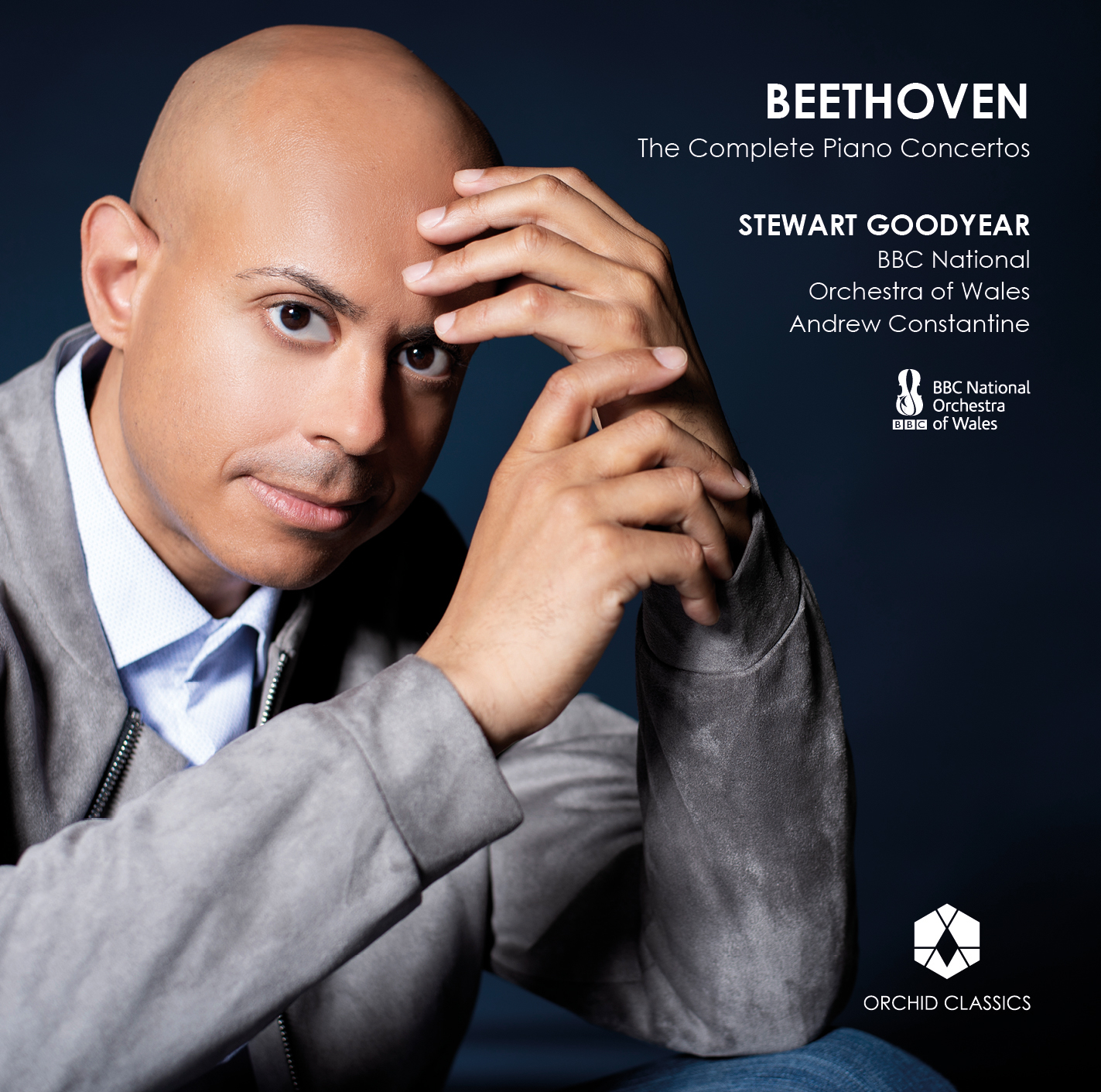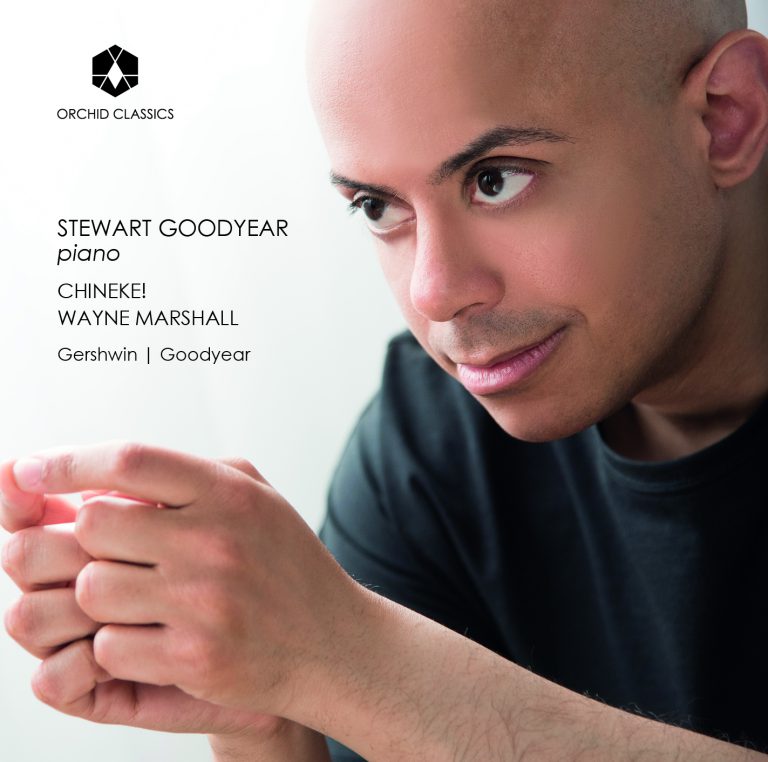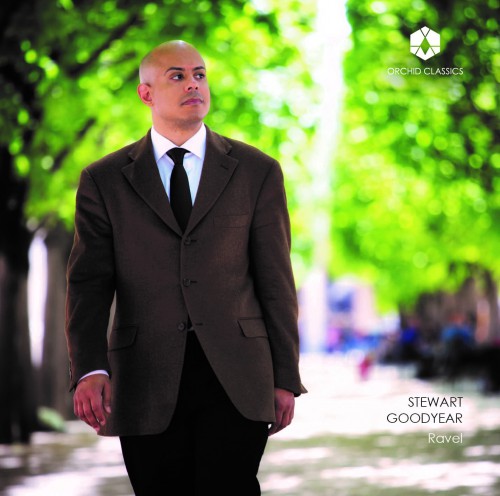Artist Led, Creatively Driven

Stewart Goodyear
Complete Beethoven Piano Concertos
BBC NOW / Constantine
Release Date: March 13th 2020
ORC100127
LUDWIG VAN BEETHOVEN (1770 – 1827)
The complete piano concertos
CD1
Concerto No.1 in C major, Op.15
1 Allegro con brio 17.01
2 Largo 11.27
3 Rondo. Allegro scherzando 9.09
Concerto No.2 in B flat major, Op.19
4 Allegro con brio 13.42
5 Adagio 8.20
6 Rondo. Molto allegro 6.01
Total time 65.42
CD2
Concerto No.3 in Cminor, Op.37
1 Allegro con brio 16.33
2 Largo 10.16
3 Rondo. Allegro 9.07
Concerto No.4 in G major, Op.58
4 Allegro moderato 18.13
5 Andante con moto 4.33
6 Rondo (Vivace) 10.08
Total time 68.54
CD3
Concerto No.5 in E flat major, Op.73 ‘Emperor’
1 Allegro 20.12
2 Adagio un poco mosso 7.54
3 Rondo (Vivace) 10.08
Total time 38.28
Stewart Goodyear, piano
BBC National Orchestra of Wales
Andrew Constantine, conductor
“The road to Elysium was indeed rocky.” That was the last sentence of my booklet notes about the complete Beethoven sonatas. Greek mythology defines Elysium as the home of the blessed after death, the resting place in the afterlife, the heavenly reward after life on earth. There is a more secular definition which puts Elysium as heaven on earth, and can mean any place or state of bliss or delight. It is that latter definition that inspires my thoughts and feelings about Beethoven in general.
My path to Beethoven began as a very introverted three year old when I first heard all of Beethoven’s piano sonatas in a single day, playing each record from a 13-LP box set on a Mickey Mouse record player. I was five when I first heard all of Beethoven’s symphonies. This box set was a legacy from my father, who died a month before I was born. This set took two years to go through…I was initially infatuated by the power of the 5th, 7th and 9th symphonies, but did not get around to the other gems until a year later. My first impression while hearing the symphonies was that they seemed more public and more extroverted as the sonatas seemed more personal and more vulnerable. The complete piano sonatas felt like hearing a musical diary; the symphonies felt like individual declarations to the public. Two sides of Beethoven so far, equally powerful, intriguingly different.
My journey with the Beethoven piano concertos began at age nine when I entered a national piano competition in Canada. From the age of nine to twelve I competed, hearing movements of his piano concerti performed by various competitors. (In the final round of this competition, the competitors had to choose a movement from a concerto.) Another side of Beethoven was introduced to me as I heard my competitors perform these works; a side of great theatre, great drama, great virtuosity, and most importantly, great merriment. I felt like I was hearing Beethoven the entertainer, the actor, the storyteller, the playwright. So now, there were three sides of Beethoven; the sonatas were pursuits of inner truth, the symphonies pursuits of the highest qualities in humanity, the piano concertos pursuits of unbridled joy.
Fast-forward to when I turned 32 and decided to, at last, perform and record the complete piano sonatas of Beethoven. This was a very personal mountain for me to climb, as I had to finally come to terms with these works, find inner truth and identity, and share them with the listener. The result was catharsis from a personal rocky road, and a profound feeling of peace and fulfillment as I recorded the last note of this enormous set of music.
I knew that I needed to record all the concertos next…but timing had to be everything. Just like my recording of the sonatas, it had to be at a time when I felt that I knew deeply what universal joy and delight felt like. The Beethoven piano concertos are, after all, public music, bringing individuality out of the private salon and into the concert hall. They are also a music of joyous collaboration, as the piano soloist, conductor and orchestra are equal team members and partners. It is a community music on the greatest level, creating a chemistry that not only strives to bring joy to the masses, but also bring a personal Elysium to the collaborators.
One year ago, I found my dream team: Andrew Constantine has been a dear friend and musician who I deeply admire…I knew he had to be my collaborator, and was delighted that he said yes when I asked whether he would be interested in recording the concertos with me. I then needed to ask my team from my Gershwin/Goodyear album, who created musical magic and brought my project to fruition. I am very grateful to have had Matthew Trusler, Andrew Constantine, Andrew Keener, Simon Eadon, Dave Rowell, and the wonderful BBC National Orchestra of Wales as part of my Elysium on Earth as I recorded Beethoven’s complete piano concertos.
Stewart Goodyear, 2019
Beethoven’s Piano Concerto No.1 in C, Op.15 was the first to be published but was his third piano concerto, following an unpublished early attempt in E flat major (1794), and a full-scale concerto published as his Concerto No.2 in B flat (started in 1787-8 and complete by 1795). The C major Piano Concerto was composed in 1795 and revised in 1800 and, as with Beethoven’s early symphonies, shows the influence of Mozart and Haydn whilst also exhibiting key aspects of Beethoven’s individual style. The first movement alone is not a perfunctory emulation of past precedents, but an ambitious, witty and bold statement.
The concerto opens with a graceful, expansive orchestral section, its elegance humorously punctured by a Haydnesque injection of energy beforemore sombre, minor-key writing leads us on a remarkably wide-ranging harmonic journey. Even in this relatively early work Beethoven was pushing boundaries, imprinting the genre with his own, indelible stamp. When the piano at last enters the fray it does so with the combination of delicacy and exhilaration that characterised the opening. There is a rich array of thematic material and more harmonic excursions, ideas that are further developed before the dramatic cadenza.
The slow movement is an exquisite, long-breathed Largo in A flat major. A conventional concerto would include a slow movement in a key more closely ‘related’ to the home key of C, but Beethoven again decided to do something different. A flat major brought out a particular tenderness in Beethoven; he also chose this key for the famous slow movement of his Pathétique Sonata, Op.13 (1798). The finale is a spirited rondo in which the lively main theme is juxtaposed with contrasting episodes. There are two cadenzas, one just before the principal theme returns for the last time, and one before the very end of the movement. Beethoven reserves one last humorous touch for the closing bars, when the piano lulls us into a false sense of security with its gentle material, swiftly dismissed by the orchestra’s decisive final chords.
On 29 March 1795 Beethoven gave the first public performance of one of his own works, a piano concerto. The concert was at the Burgtheater in Vienna and was “received with unanimous applause”. It is likely that this work was the B flat major Piano Concerto, published as the Piano Concerto No.2 in B flat, Op.19 in 1801. The orchestra is pared down compared with Beethoven’s later piano concertos, omitting clarinets, trumpets and percussion, although this does not prevent the first movement exuding a martial character in its fanfares. Even in this early work there are some surprising tonal shifts, hints of Beethoven’s adventurous spirit amidst the Mozartian material. We know that this movement was composed in Bonn between 1787 and 1789, and that Beethoven wrote the taxing cadenza rather later. The refined second movement dates from the same period as thefirst, whereas the playful rondo finale, which toys with the fashionable ‘Turkish’ style, was written in 1795 shortly before the work’s first performance in Vienna, with an alternative finale composed later for Prague (we hear the standard Viennese version).
The exact composition date of the Piano Concerto No.3 in C minor, Op.37, is uncertain, but it was probably begun in 1800, and was premiered alongside the Second Symphony on 5 April 1803, with Beethoven at the piano. The concerto was published in 1804 with a dedication to Prince Louis Ferdinand of Prussia.
As with the Piano Concerto No.1, the orchestra sets the scene, establishing a dramatic atmosphere reminiscent of Mozart’s stormy minor-key works, contrasted with more lyrical, pastoral material. The piano enters with a powerful ascending statement, Beethoven establishing a sophisticated relationshipbetween soloist and orchestra via scintillating exchanges and varied textures, the piano part possessing a new, Romantic richness. A tempestuous, trill-laden cadenza precedes the coda, during which Beethoven teases us with a long trill before the spine-tingling final bars. The slow movement begins with exquisitely introspective music for the piano alone before the orchestra envelops the soloist and seamlessly takes over, establishing a new sense of intimacy between soloist and ensemble. The rondo finale boasts a distinctive and memorable theme, and the work ends in C major.
Beethoven conceived his Piano Concerto No.4 in G, Op.58 in early 1804, when he sketched five bars of the work. This short passage would prove crucial to the concerto’s composition, remaining largely unchanged in the final version and generating a significant amount of material as well as establishing the piece’s lyrical nature. Beethoven worked on the Piano Concerto No.4 in 1805 and completed it during 1806. Its first performances were given privately, with Beethoven as soloist, before he gave the public premiere on 22 December 1808 in Vienna. The Allgemeine musikalische Zeitung pronounced the work to be “the most admirable, singular, artistic and complex Beethoven concerto”.
This concerto is characterised by an original approach to the linking of different sections; its five-bar phrase structure reappears in the main theme of the second movement, and is transformed into a phrase of ten bars in the third. The opening was unprecedented, the usual orchestral introduction supplanted by musicfor piano alone. This innovation establishes a deep intimacy between soloist and orchestra; the soloist’s phrases can be heard growing out of the orchestral texture, and in the slow movement the piano seems to plead with a forceful ensemble. This movement flows seamlessly into the final rondo, which continues the work’s tussle between power and lyricism. During the final bars, twinkling piano writing sustains a sense of fragility until the last moment, when a crescendofor both soloist and orchestra unfurls a final, joyful flourish.
In 1805 Beethoven wrote: “God knows why my piano music still makes the poorest impression on me”. Within a few years this apparent struggle had been overcome, culminating in his final complete concerto, the Piano Concerto No.5 in E flat, Op.73. The concerto’s sketches offer further insights into Beethoven’s state ofmind. Since 1808 he had been staying with the separated Countess Marie Erdödy; when he discovered that she was bestowing large sums of money on his servant, Beethoven assumed a seedy transaction, scribbling on draft pages of the concerto: “What more can you want? You have received the servant from me instead of the master… What a substitution!!!! What a glorious exchange!!!!” He promptly moved out. The slow movement bears another bitter remark: “Austria rewards Napoleon”; Beethoven, who had once idolised Napoleon, was by now disgusted at the repercussions of the leader’s power-hungry actions.
The concerto was premiered in Leipzig in 1810, to thunderous applause. The subtitle, ‘Emperor’, was not Beethoven’s own but was added later. When the work was published in February 1811 it was dedicated to his student Archduke Rudolph, son of Emperor Leopold II. The music unfolds in a majestic, symphonic sweep, starting with an innovative gesture: an extended cadenza for the soloist, supported by powerful tutti chords, summarising in miniature the whole first movement. In the beautiful slow movement the piano is given graceful material that foreshadows Chopin. An orchestral held note bridges the gap between the Adagio and a brilliant, jubilant rondo finale.
© Joanna Wyld, 2019
Stewart Goodyear
Proclaimed “a phenomenon” by the Los Angeles Times and “one of the best pianists of his generation” by the Philadelphia Inquirer, Stewart Goodyear is an accomplished young pianist as a concerto soloist, chamber musician, recitalist and composer. Mr. Goodyear has performed with major orchestras of the world , including the Philadelphia Orchestra, New York Philharmonic, Chicago Symphony, Pittsburgh Symphony, San Francisco Symphony, Los Angeles Philharmonic, Cleveland Orchestra, Academy of St Martin in the Fields, Bournemouth Symphony, Frankfurt Radio Symphony, MDR Symphony Orchestra (Leipzig), Montreal Symphony, Toronto Symphony Orchestra, Dallas Symphony , Atlanta Symphony, Baltimore Symphony, Detroit Symphony, Seattle Symphony, Mostly Mozart Festival Orchestra, Royal Liverpool Philharmonic, and NHK Symphony Orchestra.
Mr. Goodyear began his training at The Royal Conservatory in Toronto, received his bachelor’s degree from Curtis Institute of Music, and completed his master’s at The Juilliard School. Known as an improviser and composer, he has been commissioned by orchestras and chamber music organizations, and performs his own solo works. Last year, Mr. Goodyear premiered his suite for piano and orchestra, “Callaloo”, with Kristjan Jarvi and MDR Symphony Orchestra in Leipzig, and last summer, the Clarosa Quartet premiered his Piano Quartet commissioned by theKingston Chamber Music Festival. Mr. Goodyear performed all 32 Beethoven Piano Sonatas in one day at Koerner Hall, McCarter Theatre, the Mondavi Center, and the AT&T Performing Arts Center in Dallas.
Mr. Goodyear’s discography includes Beethoven’s Complete Piano Sonatas (which received a Juno nomination for Best Classical Solo Recording in 2014) and Diabelli Variations for the Marquis Classics label, Tchaikovsky’s First Piano Concerto and Grieg’s Piano Concerto,and Rachmaninov’s Piano Concertos No. 2 and 3, both recorded with the Czech National Symphony under Stanislav Bogunia and Hans Matthias Forster respectively, and released to critical acclaim on the Steinway and Sons label. His Rachmaninov recording received a Juno nomination for Best Classical Album for Soloist and Large Ensemble Accompaniment. Also for Steinwayand Sons is Mr. Goodyear’s recording of his own transcription of Tchaikovsky’s “The Nutcracker (Complete Ballet)”, which was released October 2015 and was chosen by the New York Times as one of the best classical music recordings of 2015. Mr. Goodyear’s recording of Ravel’s piano works was released on the Orchid Classics label in the spring of 2017, and his new recording “For Glenn Gould”, that combines repertoire performed by Gould in his US and Montreal debuts, was released March 2018.
Highlights of the 2018-10 season have been a UK tour with Chineke!, return engagements with the Philadelphia Orchestra, Toronto, Vancouver and Victoria Symphony orchestras, and three recitals for the Chamber Music Society of Detroit. His new concerto, “Ur-”, was commissioned by The Royal Conservatory of Music in Toronto, and premiered by the Toronto Symphony January 2019. Mr. Goodyear’s Cello Concerto, commissioned by the National Arts Centre Orchestra in Ottawa, will be premiered in the 2019-20 season.
Patrick Rucker, Gramophone
“Goodyear… is a pianist of tremendous clarity and precision. He has a beautiful, silver sound, with perfectly lucid trills that must be the envy of his colleagues.”
Fiona Maddocks, The Guardian
“Would this deep obsession give his Complete Beethoven Piano Concertos, with the BBC National Orchestra of Wales and Andrew Constantine, edge or distinction in a crowded market? Yes. The results are fleet-fingered, insightful and imaginative, capturing an essential sense of improvisation in the cadenzas…”
Malcolm Hayes, BBC Music Magazine
“Goodyear’s playing style is a masterclass in American-style confidence at its most likeable – free of any trace of brashness, with the quick outer movements full of engaging verve and articulated with immaculate clarity at every point.”
American Record Guide
“…this time Goodyear displays so much intelligence, alertness, articulation, pulse, sheer technical perfection, and artistry that this album, warts and all, is like a magnet that will keep drawing me back.”
Jonathan Blumhofer, The Arts Fuse
“…to be sure, a big part of the sheer joy of this set comes from experiencing the kinetic rapport between pianist, orchestra, and conductor on display in each of these works.”
John J. Puccio, Classical Candor
“The thing about Goodyear is that his playing is never fussy; everything is there for a purpose, with no frills. This works especially well in the slow, introspective Largo, where Goodyear equals anyone in his nuance and subtlety.”
Jed Distler, Classics Today
“In addition to the sheer joy and exuberance Goodyear displays in the first two concertos’ outer movements, the pianist’s specificity insofar as Beethoven’s phrasing, accents, and subito dynamics are concerned enhance the music’s dramatic profile without ever sounding fussy or pedantic: indeed, quite the opposite!”
Dan Morgan, Music Web International
“Glorious, life-embracing performances, very well recorded; surely a high point of the composer’s birthday year (or any other, for that matter).”
Steve Moffat, Limelight Magazine
“…Goodyear’s case is eloquently made and he shows plenty of character and fine judgement and an evenness of quality throughout.”
Anya Wassenberg, Ludwig Van Toronto
“There’s a natural and unfettered flow to the music, with speed that is impressive and technique pristine, but where virtuosity is always incidental to expression.”
Robert Cummings, Music Web International
“…Goodyear clearly stands with or ahead of the best. His cycle is a major achievement and certainly places him among the foremost interpreters of these Beethoven masterpieces.”
David Truslove, Wales Art Review
“…this is a highly enjoyable three-disc set exhibiting commendable poise and clarity”
Robert Rowat, CBC
“This album arrives as a silver lining, with impressive, heartfelt playing from Goodyear, and generally brisk tempi from conductor Constantine, which help accentuate what Goodyear calls the “unbridled joy” of these war horses.”









